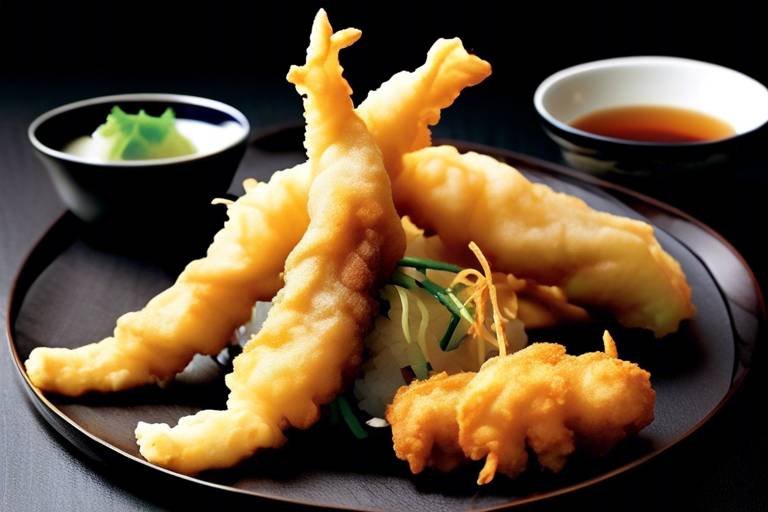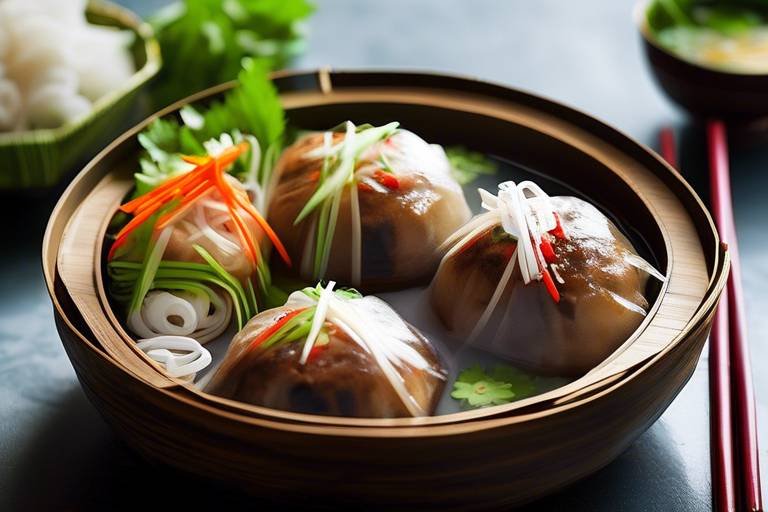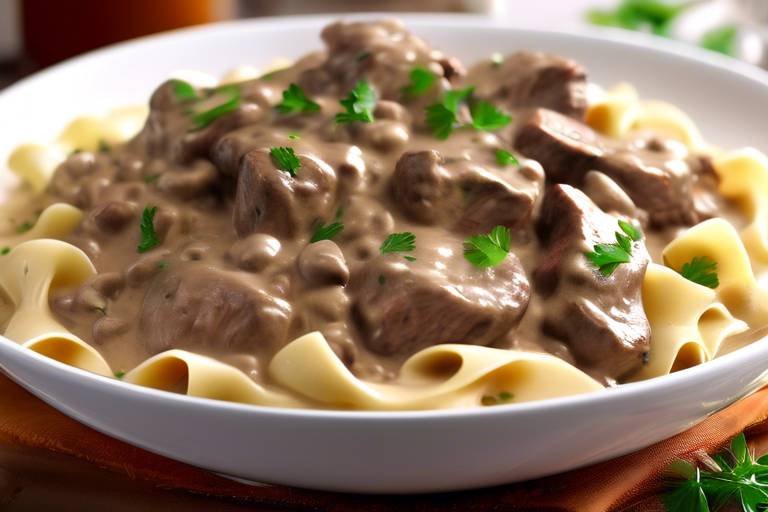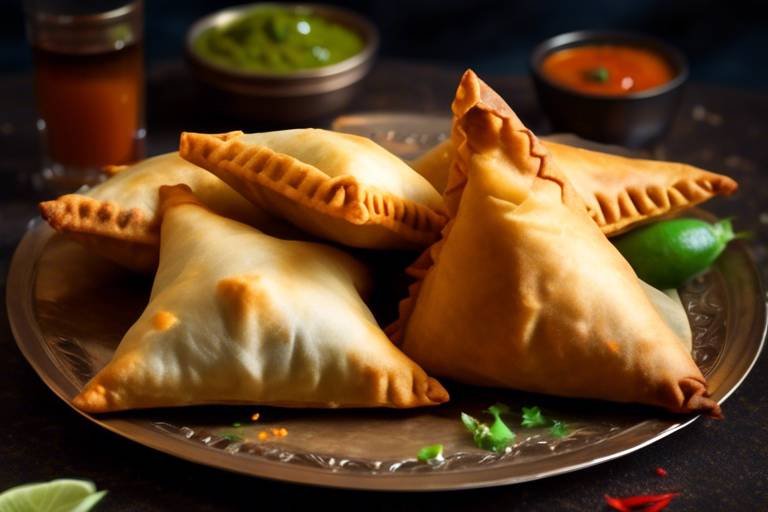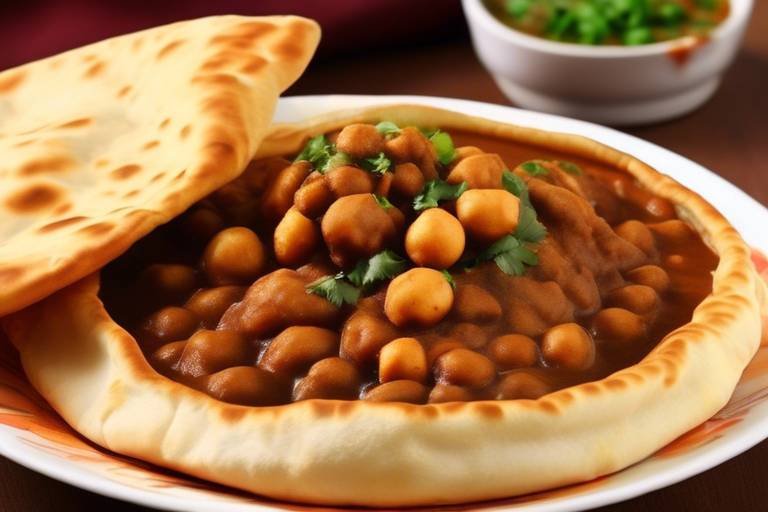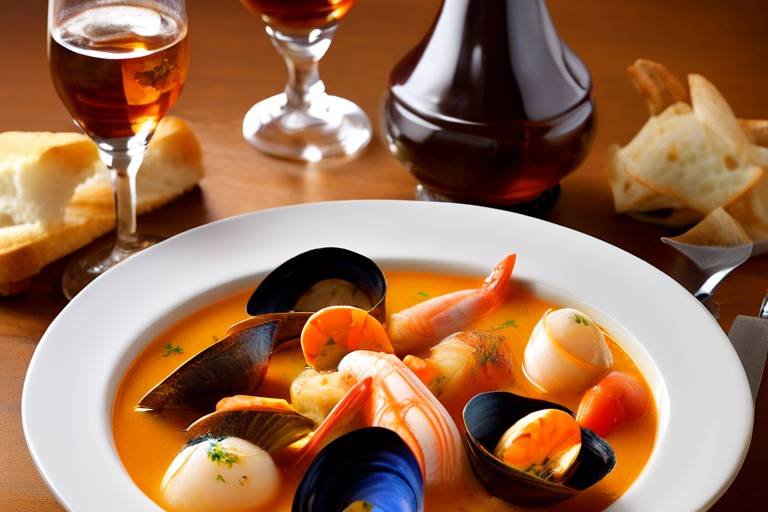The Ultimate Guide to Vietnamese Com Tam
Are you ready to embark on a culinary adventure through the vibrant flavors of Vietnamese cuisine? Look no further than the iconic dish of Com Tam. This ultimate guide will take you on a journey through the rich history, diverse variations, and the art of enjoying Com Tam to the fullest.

History of Com Tam
Discover the rich and flavorful world of Vietnamese cuisine through the iconic dish Com Tam. From its history to variations and how to enjoy it, this guide will immerse you in the delicious culture of Com Tam.
The history of Com Tam dates back to the rice fields of Vietnam, where it was originally a simple meal enjoyed by farmers during their lunch breaks. Com Tam, which translates to "broken rice," was born out of a necessity to utilize broken grains of rice that were considered inferior. Over time, this humble dish evolved into a beloved staple in Vietnamese cuisine, cherished for its unique texture and ability to absorb flavors.
During the French colonial period, Com Tam gained popularity beyond the agricultural sector and became a common street food in urban areas. Its affordability and delicious taste made it a favorite among people from all walks of life. Today, Com Tam is not only a symbol of Vietnamese culinary heritage but also a testament to the resourcefulness and creativity of its people.
The cultural significance of Com Tam extends beyond its culinary appeal. It represents resilience, adaptability, and the ability to transform humble ingredients into a gastronomic delight. As Vietnam's culinary landscape continues to evolve, Com Tam remains a timeless classic that embodies the spirit of the country.
Through its journey from a simple farmer's meal to a beloved national dish, Com Tam has become a cultural icon that reflects the rich history and traditions of Vietnam.
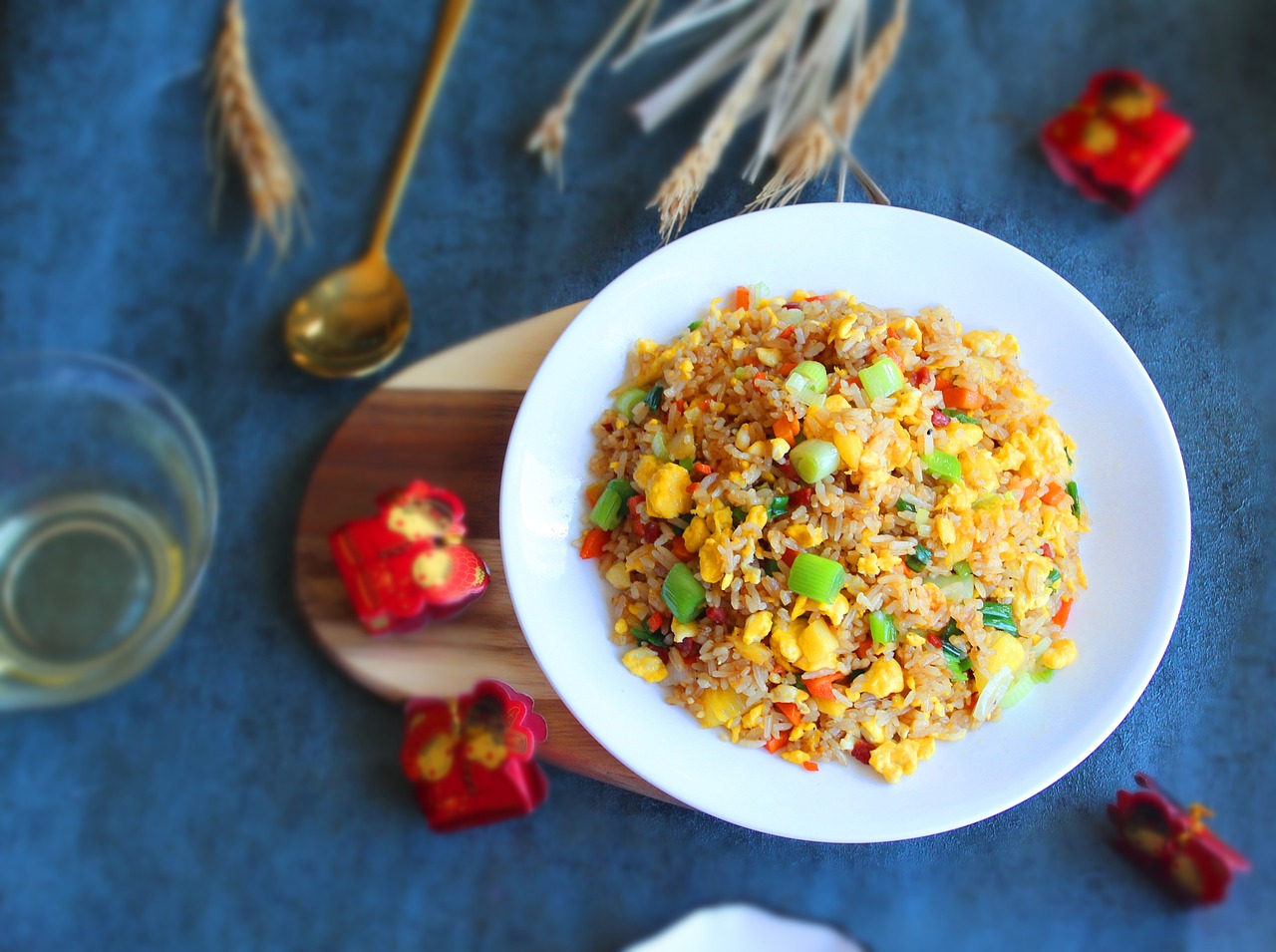
Ingredients Used in Com Tam
When it comes to creating the delectable dish of Com Tam, the key lies in the selection of high-quality ingredients that come together to form a harmonious and flavorful meal. At the heart of Com Tam is fragrant jasmine rice, a staple in Vietnamese cuisine known for its subtle aroma and fluffy texture. This rice serves as the foundation of the dish, providing a satisfying base for the other components to shine.
One of the essential elements of Com Tam is the succulent grilled meats that adorn the rice. Typically, a combination of marinated pork chops, grilled shrimp, and thinly sliced pork skin are featured, each offering a unique taste and texture to the dish. The meats are expertly grilled to perfection, imparting a smoky flavor that enhances the overall experience of Com Tam.
Complementing the rice and meats are a variety of fresh herbs and vegetables that add brightness and freshness to the dish. Common additions include crisp cucumber slices, tangy pickled carrots and daikon, aromatic mint leaves, and pungent fish sauce dressing. These elements not only provide a burst of flavor but also contribute to the visual appeal of the dish, creating a vibrant and inviting plate of Com Tam.
To elevate the dish further, a side of pickled vegetables or a fried egg may be included, adding additional layers of taste and texture. The interplay of savory, sweet, sour, and spicy flavors in Com Tam showcases the complexity and balance of Vietnamese cuisine, making each bite a delightful journey for the palate.

Variations of Com Tam
When it comes to Com Tam, the variations of this beloved Vietnamese dish are as diverse as the country itself. Each region in Vietnam puts its own unique spin on Com Tam, offering a culinary adventure for food enthusiasts. From the bustling streets of Ho Chi Minh City to the tranquil villages of Hanoi, the variations of Com Tam showcase the rich tapestry of Vietnamese cuisine.
In Southern Vietnam, Com Tam is often served with a generous portion of broken rice topped with grilled pork, a crispy egg cake, and a side of pickled vegetables. The combination of textures and flavors creates a harmonious dish that is both satisfying and delicious. This variation is a favorite among locals and tourists alike, capturing the essence of Southern Vietnamese cuisine.
Heading to Central Vietnam, you may encounter a different take on Com Tam, where the dish is served with grilled shrimp, a tangy fish sauce dressing, and a medley of fresh herbs. The coastal influence is evident in this variation, with an emphasis on seafood and vibrant flavors. The combination of sweet, savory, and spicy elements makes Central Vietnamese Com Tam a standout choice for seafood lovers.
In Northern Vietnam, Com Tam takes on a more rustic and hearty form, with grilled chicken or beef served alongside a flavorful tomato-based sauce and a side of crispy fried shallots. The earthy flavors and robust ingredients reflect the agricultural traditions of the region, offering a comforting and soul-warming meal. This variation of Com Tam is perfect for those seeking a hearty and satisfying dining experience.
Regardless of the region, one thing remains constant – the love and passion that goes into preparing Com Tam. Whether it's the careful selection of ingredients, the meticulous grilling of meats, or the artful arrangement of the dish, each variation of Com Tam tells a story of Vietnamese culinary heritage and tradition. Exploring the different variations of Com Tam is not just a culinary journey, but a cultural experience that will leave you craving for more.

How to Make Com Tam at Home
Are you ready to bring the authentic flavors of Vietnam into your own kitchen? Making Com Tam at home is a rewarding experience that allows you to savor the delicious taste of this beloved dish whenever you crave it. To start your culinary journey, gather the essential ingredients such as fragrant jasmine rice, tender grilled meats, fresh herbs, and pickled vegetables. These components come together to create a harmonious blend of flavors and textures that define Com Tam.
Begin by cooking the jasmine rice to perfection, ensuring each grain is fluffy and fragrant. While the rice is cooking, prepare the marinated meats, typically pork chops or shredded pork skin, seasoned with a blend of spices and sauces for an authentic taste. The meats are then grilled to perfection, imparting a smoky flavor that enhances the overall dish.
As the rice and meats are being prepared, don't forget to assemble the accompanying elements that complete the dish. Fresh herbs like cilantro, mint, and Thai basil add a burst of freshness, while pickled vegetables provide a tangy contrast to the rich flavors of the meats and rice. Traditional fish sauce dressing can be drizzled over the dish for an added depth of flavor.
Once all the components are ready, it's time to plate up your homemade Com Tam. Arrange the fragrant jasmine rice at the base of the plate, topped with the grilled meats and a generous sprinkling of fresh herbs. Add the pickled vegetables on the side for a colorful and flavorful touch. The final step is to drizzle the dish with the savory fish sauce dressing, bringing all the elements together in a symphony of taste.
Invite your family and friends to gather around the table and savor the fruits of your labor. Enjoy the satisfying flavors and textures of homemade Com Tam, knowing that you have mastered the art of creating this iconic Vietnamese dish in the comfort of your own home.

Best Places to Enjoy Com Tam in Vietnam
When it comes to experiencing the authentic flavors of Com Tam in Vietnam, there are a plethora of fantastic places that offer this beloved dish. From bustling street food stalls to upscale restaurants, the options are endless for those looking to indulge in a delicious plate of Com Tam.
One of the best places to enjoy Com Tam in Vietnam is the vibrant Ben Thanh Market in Ho Chi Minh City. Here, visitors can immerse themselves in a bustling atmosphere while sampling a variety of Com Tam dishes prepared by local vendors. The market's lively ambiance adds an extra layer of excitement to the dining experience, making it a must-visit destination for food enthusiasts.
For those seeking a more upscale setting, restaurants like Nha Hang Ngon in Hanoi offer a refined take on Com Tam. With elegant decor and a diverse menu featuring different variations of the dish, diners can enjoy a luxurious dining experience while savoring the flavors of this traditional Vietnamese favorite.
If you prefer a more laid-back dining experience, exploring the streets of Hue can lead you to hidden gems that serve mouthwatering Com Tam. The city's rich culinary heritage shines through in each bite, offering a unique and memorable dining experience for visitors.
Additionally, venturing off the beaten path to smaller towns and villages in Vietnam can uncover hidden culinary treasures where locals prepare Com Tam with authentic flavors and traditional techniques. These hidden gems provide a glimpse into the heart of Vietnamese cuisine, offering a truly immersive dining experience.
Whether you prefer the bustling energy of a market stall or the refined elegance of a restaurant, Vietnam offers a diverse range of options for enjoying the delectable flavors of Com Tam. Each dining establishment brings its own unique twist to this beloved dish, making the culinary journey through Vietnam an unforgettable experience.

Health Benefits of Com Tam
When it comes to Com Tam, the benefits extend beyond just its delicious taste. This iconic Vietnamese dish offers a range of health benefits that make it a wholesome choice for your diet. One of the key advantages of Com Tam is its balanced combination of ingredients, providing a mix of essential nutrients to fuel your body.
First and foremost, Com Tam is typically served with jasmine rice, which is a good source of carbohydrates for energy. Paired with grilled meats such as pork or chicken, this dish offers a healthy dose of protein to support muscle growth and repair. Additionally, the inclusion of fresh herbs and vegetables in Com Tam adds fiber, vitamins, and minerals to promote overall well-being.
Moreover, the way Com Tam is prepared, with minimal use of oil and emphasis on grilling, makes it a lighter and lower-fat option compared to other fried dishes. This cooking method helps retain the natural flavors of the ingredients while keeping the dish nutritious.
Furthermore, Com Tam often incorporates fish sauce, a staple condiment in Vietnamese cuisine known for its umami flavor. Fish sauce is rich in antioxidants and essential amino acids, offering potential health benefits such as improved digestion and immune support.
Overall, indulging in a plate of Com Tam not only satisfies your taste buds but also nourishes your body with a range of nutrients essential for a well-rounded diet. So, next time you savor this flavorful dish, know that you are not only enjoying a culinary delight but also reaping the health benefits it has to offer.

Com Tam Etiquette and Traditions
When it comes to enjoying Com Tam in Vietnam, there are certain etiquette and traditions that are important to observe. Vietnamese cuisine is deeply rooted in cultural customs, and Com Tam is no exception. From how the dish is served to the way it is eaten, here are some key aspects of Com Tam etiquette and traditions that you should be aware of.
One of the essential aspects of enjoying Com Tam is the way it is presented. Typically, Com Tam is served on a large plate or in a bowl, with each component neatly arranged to create a visually appealing dish. The presentation of Com Tam is considered an art form in Vietnamese culture, reflecting the care and attention to detail that goes into preparing the meal.
When eating Com Tam, it is customary to use chopsticks and a spoon. Chopsticks are used to pick up the meat and other solid ingredients, while the spoon is used to scoop up the rice and sauce. This method of eating ensures that you can enjoy all the different flavors and textures of the dish in each bite.
In Vietnamese culture, sharing food is a common practice that fosters a sense of community and togetherness. When dining with others, it is customary to offer to share your Com Tam or to take a small portion from a shared plate. This gesture of generosity and camaraderie is an integral part of the dining experience.
Another important aspect of Com Tam etiquette is the use of condiments and sauces. Vietnamese cuisine is known for its flavorful sauces and condiments, and Com Tam is no exception. Common accompaniments include fish sauce, chili sauce, and pickled vegetables, which can be added to the dish according to personal taste preferences.
Furthermore, when enjoying Com Tam in a traditional setting, it is important to show respect for the food and the people you are dining with. This includes refraining from wastage, eating with moderation, and expressing gratitude for the meal. By observing these customs, you can fully appreciate the cultural significance of Com Tam and enjoy a truly authentic dining experience.

Pairing Com Tam with Vietnamese Beverages
When it comes to enjoying the delightful flavors of Com Tam, choosing the perfect beverage pairing can elevate your dining experience to new heights. Vietnamese cuisine offers a wide array of beverages that complement the rich and savory taste of this iconic dish. One of the most popular choices is traditional Vietnamese iced coffee, known for its strong and aromatic flavor that perfectly balances the hearty components of Com Tam. The refreshing combination of the sweet and creamy coffee with the savory elements of the dish creates a harmonious blend of flavors that will tantalize your taste buds.
In addition to iced coffee, herbal teas are another excellent option for pairing with Com Tam. These fragrant and soothing teas provide a light and cleansing accompaniment to the hearty meal, offering a refreshing contrast to the savory flavors of the dish. Whether you prefer a classic green tea or a more exotic blend of herbs and spices, the diverse selection of Vietnamese herbal teas can cater to a variety of taste preferences, enhancing the overall dining experience.
For those looking for a non-caffeinated option, fresh fruit juices are a popular choice to enjoy alongside Com Tam. The natural sweetness and vibrant flavors of fruit juices complement the savory components of the dish, creating a refreshing and balanced combination. From tropical favorites like mango and pineapple to more traditional choices such as orange and guava, the versatility of fruit juices allows you to customize your beverage pairing to suit your personal taste preferences.
Frequently Asked Questions
- What is Com Tam?
Com Tam is a traditional Vietnamese dish consisting of broken rice served with various toppings such as grilled meats, pickled vegetables, and fish sauce. It is a popular street food in Vietnam known for its flavorful and satisfying combination of ingredients.
- What makes Com Tam different from regular rice?
Com Tam is made from broken rice grains, which have a different texture compared to regular long-grain rice. The broken rice grains absorb flavors more easily, giving Com Tam a unique taste and mouthfeel that sets it apart from traditional rice dishes.
- Are there vegetarian options for Com Tam?
Yes, there are vegetarian versions of Com Tam available that feature tofu, mushrooms, or plant-based proteins as substitutes for the grilled meats. These vegetarian options still maintain the essence of Com Tam while catering to those with dietary preferences.
- Can I customize the toppings in Com Tam?
Absolutely! One of the joys of Com Tam is the ability to customize the toppings based on your preferences. Whether you prefer pork, chicken, seafood, or vegetarian options, you can mix and match toppings to create your perfect plate of Com Tam.
- Is Com Tam a healthy dish?
Com Tam can be a healthy dish as it often includes a balance of protein, carbohydrates, and vegetables. The use of fresh herbs and vegetables, along with grilled meats, provides a nutritious meal option that can be part of a well-rounded diet.



